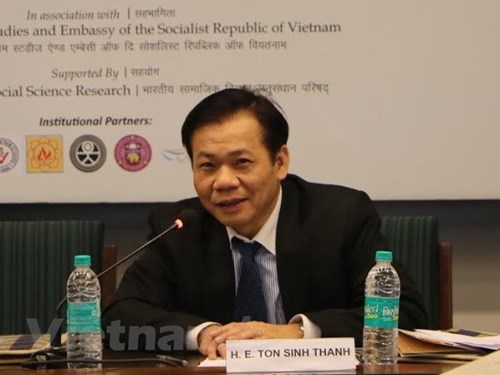The workshop was co-organized by the Vietnamese Embassy in India and the Center for Vietnamese Studies in India, and the Nehru Memorial Museum and Library, with Indian Minister of Commerce and Industry Shri Suresh Prabhu and Minister of State for External Affairs V. K. Singh in attendance.
Thanh highlighted economic cooperation as one of the five pillars of the Vietnam-India Comprehensive Strategic Partnership, which was set up during the visit of Indian Prime Minister Narendra Modi to Vietnam in September 2016.
    |
 |
|
Vietnamese Ambassador to India Ton Sinh Thanh addresses the conference. Photo: Vietnam+ |
During the visit of President Tran Dai Quang and Prime Minister Nguyen Xuan Phuc to India earlier this year, leaders of both sides called for concerted efforts to boost bilateral economic relations, in particular elevating bilateral trade to USD 15 billion by 2020, the diplomat said.
He expressed his confidence that the goal would be achieved for the three following reasons. Firstly, Vietnam and India boast a strong political foundation, facilitating the expansion of economic ties. Secondly, both Vietnam and India have posted robust economic growth in recent times, creating many opportunities for economic cooperation. Lastly, bilateral economic ties have already progressed well over the past few years and are likely to continue doing so, he explained.
Last year, bilateral trade amounted to USD 7.7 billion, an increase of 42 percent from the previous year. In the first half of 2018, the figure rose by 48 percent year-on-year to USD 5.44 billion and, if this trend continues, it can reach USD 11 billion by the end of this year, Thanh noted.
From January to June, Indian investors have injected approximately USD 876 million into 190 projects in Vietnam, a year-on-year increase of 29 percent.
Tourist arrivals from India to Vietnam have risen an average of 17 percent year-on-year since 2010. Some 150,000 Indian travelers are expected to visit Vietnam and some 70,000 Vietnamese will travel to India this year.
However, the Vietnamese ambassador noted that there are many opportunities for economic cooperation between the two countries that have yet to be tapped. He cited the fact that two-way trade remains modest compared to the USD 425 billion in Vietnam’s total foreign trade and India’s USD 781 billion last year. The number accounted for less than 10 percent of trade between India and ASEAN nations.
Of the 22 million Indian people traveling abroad last year, 3.5 million visited Southeast Asia but only 110,000 came to Vietnam. Meanwhile, Indian arrivals to Thailand totaled 1.6 million, he said.
He expected that the conference would provide insights to help Vietnam and India foster their bilateral ties in trade, investment, and tourism in the time ahead.
For his part, Minister of State for External Affairs V. K. Singh said the two nations possess huge potential to expand cooperation in the fields of pharmaceuticals, health care, petroleum, renewable energy, agriculture, tourism, textile and garments, leather, and mining.
Minister of Commerce and Industry Suresh Prabhu referred to Vietnam as one of the fastest growing economies in ASEAN and as a bridge between India and other member countries of the bloc. The two sides have established strong partnership in oil exploitation, manufacturing, defense, and services.
At the conference, attendees focused their discussion around several topics, including: “India-Vietnam Bilateral Trade: Issues and Prospects,” “Infrastructure and Development Partnership between India and Vietnam,” “Energy Cooperation between India and Vietnam,” “Exploring India-Vietnam Economic Realities and Business Culture,” “Improvement in India-Vietnam Regional Value Chain,” “Made-in-India Scheme and Opportunities for Vietnam,” and “India-Vietnam Economic Cooperation in the Context of Trade Agreements and Partnerships.”
Source: VNA